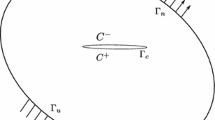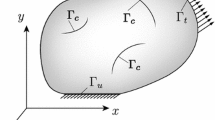Abstract
In the present paper, based on the theory of dynamic boundary integral equation, an optimization method for crack identification is set up in the Laplace frequency space, where the direct problem is solved by the author's new type boundary integral equations and a method for choosing the high sensitive frequency region is proposed. The results show that the method proposed is successful in using the information of boundary elastic wave and overcoming the ill-posed difficulties on solution, and helpful to improve the identification precision.
Similar content being viewed by others
References
Huang WH, Ma YR, Zhou ZZ, et al. Trends and opportunities on inverse problems in elastodynamics.Chinese J of Appl Mech, 1994, 11(3), 1–10 (in Chinese)
Yang HZ, Zhang YG, Lu XR. The inverse problems in solid dynamics. In: Huang KZ ed. The Development Trends on Solid Mechanics. Beijing: Press of University of Beijing Science and technology, 1994, 55–73 (in Chinese)
Kubo S. Requirements for uniqueness of crack identification from electric potential distributions. In: Yamaguti M ed. ICM-90 Satellite Conference Proceedings, Tokyo: Springer-Verlag, 1990. 52–58
Gubernatis JE, Domany E, Krumhansl JA. Formal aspect of the theory of scattering of ultrasound by flaws in elastic materials.J Appl Phys, 1977, 48(7): 2804–2812
Huang WH, Zhou ZZ, Ma YR, et al. BORN approximation method in inverse problems of elastodynamics, In: Huang KZ ed. Solid Mechanics and its Engineering Applications. Beijing: Press of Tsinghua University, 1993, 126–135 (in Chinese)
Achenbach JD, Sotiropoulos DA, Zhu H. Characterization of cracks from ultrasonic scattering data.J of Appl Mech, Trans of ASME, 1987, 54(2): 754–760
Tanaka M, Nakamura M, Nakano T. Detection of cracks in structural components by elastodynamic boundary element method. In: Boundary Elements, XII, Vol.2, Tokyo: Springer-Verlag, 1990. 413–424
Nishimura N. Regularized integral equations for crack shape determination problems. In: Yamaguti M ed. ICM-90 Satellite Conference Proceedings. Tokyo: Springer-Verlag, 1990. 59–65
Chen YM, Xie GQ. An iterative method for simultaneous determination of bulk and shear moduli and density variations.J of Comput Phys, 1986, 62(1): 43–163
Chen WJ, Liu CT. Singular integral equation method for plane fracture dynamic problem.J of Lanzhou University, 1996, 32(1): 31–35 (in Chinese)
Fox RL. Optimization Methods for Engineering Design. Massachusetts: Addison-Wesley Publishing Co., 1971. 38–116
Author information
Authors and Affiliations
Additional information
The project supported by Foundation of the National Post-Doctoral Committee.
Rights and permissions
About this article
Cite this article
Weijiang, C., Chuntu, L. A biem optimization method for fracture dynamics inverse problem. Acta Mech Sinica 12, 263–271 (1996). https://doi.org/10.1007/BF02486812
Received:
Revised:
Issue Date:
DOI: https://doi.org/10.1007/BF02486812




